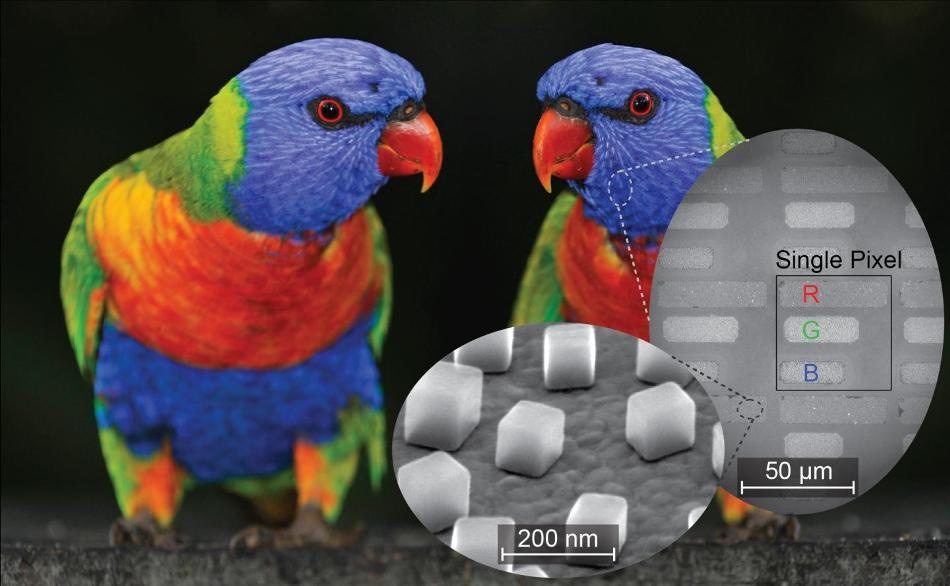Dec 15 2016
 Researchers tested a new technique for printing and imaging in both color and infrared with this image of a parrot. The inlay shows how a simple RGB color scheme was created by building rectangles of varying lengths for each of the colors, as well as individual nanocubes on top of a gold film that create the plasmonic element. (CREDIT - imageBROKER / Alamy Stock Photo)
Researchers tested a new technique for printing and imaging in both color and infrared with this image of a parrot. The inlay shows how a simple RGB color scheme was created by building rectangles of varying lengths for each of the colors, as well as individual nanocubes on top of a gold film that create the plasmonic element. (CREDIT - imageBROKER / Alamy Stock Photo)
Researchers at Duke University believe that they have conquered a longstanding obstacle in producing cheaper, more robust processes to print and image spanning a range of colors extending into the infrared. There are a broad range of "colors" across the electromagnetic spectrum that humans cannot see, but will provide a wealth of information.
Sensors designed to extend into the infrared can, for example, identify numerous minerals and plants, predict weather patterns, and diagnose cancerous melanomas just by the spectrum of light they reflect.
Existing imaging technologies that can detect infrared wavelengths are pricey and bulky, requiring complex assemblies or plenty of filters in front of an infrared photodetector. The need for mechanical movement in such devices decreases their estimated lifetime and can be a problem in harsh conditions, such as those experienced by satellites.
In a recent paper, researchers from Duke reveal a manufacturing method that has the potential to bring a simplified form of multispectral imaging into everyday use. As the process uses currently available materials and fabrication methods that are economical and easily scalable, it could transform any industry where multispectral printing or imaging is used.
The results have been published in the December 14 online issue of the journal Advanced Materials.
It's challenging to create sensors that can detect both the visible spectrum and the infrared. Traditionally you need different materials that absorb different wavelengths, and that gets very expensive, but with our technology, the detectors' responses are based on structural properties that we design rather than a material's natural properties. What's really exciting is that we can pair this with a photodetector scheme to combine imaging in both the visible spectrum and the infrared on a single chip.
Maiken Mikkelsen, the Nortel Networks Assistant Professor of Electrical and Computer Engineering and Physics, Duke University
The new technology relies on plasmonics - the use of nanoscale physical phenomena to capture specific frequencies of light.
Researchers design silver cubes barely 100 nm wide and place them just a few nanometers above a thin gold foil. When incoming light strikes the surface of a nanocube, it excites the electrons in the silver, capturing the energy of the light - but only at a specific frequency.
The size of the silver nanocubes and their distance from the base layer of gold establishes that frequency, while manipulating the spacing between the nanoparticles allows the strength of the absorption to be tweaked. By precisely customizing these spacings, researchers can make the system react to any specific color they want, from visible wavelengths right up to the infrared.
The research team will now have to deal with the challenge of how to construct a useful device that could be scalable and economical enough to use in the real world. For that, Mikkelsen looked to her research team, including graduate student Jon Stewart.
Similar types of materials have been demonstrated before, but they've all used expensive techniques that have kept the technology from transitioning to the market. We've come up with a fabrication scheme that is scalable, doesn't need a clean room and avoids using million-dollar machines, all while achieving higher frequency sensitivities. It has allowed us to do things in the field that haven't been done before.
Jon Stewart, Graduate Student, Duke University
To construct a detector, Mikkelsen and Stewart used a method of light etching and adhesives to design the nanocubes into pixels possessing various sizes of silver nanocubes, and each sensitive to a specific wavelength of light. When incoming light touches the array, each area reacts differently based on the wavelength of light it is responsive to. A computer can rebuild what color the original light was, by teasing out how each part of the array reacts.
The team demonstrated that the method can be used for printing as well. Instead of forming pixels with six sections tuned to react to specific colors, they formed pixels with three bars that reflect three colors: blue, green and red. By manipulating the relative lengths of each bar, they can order what combination of colors the pixel reflects. It is a novel upgrade on the classic RGB scheme formerly used in photography in 1861.
But in contrast to most other applications, the plasmonic color scheme has the potential to never fade over time and can be reliably reproduced with tight accuracy repeatedly. It also allows its adopters to develop color schemes in the infrared.
Again, the exciting part is being able to print in both visible and infrared on the same substrate. You could imagine printing an image with a hidden portion in the infrared, or even covering an entire object to tailor its spectral response.
Maiken Mikkelsen, the Nortel Networks Assistant Professor of Electrical and Computer Engineering and Physics, Duke University
This research was supported by the Air Force Office of Scientific Research Young Investigator Research Program (AFOSR, Grant. No. FA9550-15-1-0301).